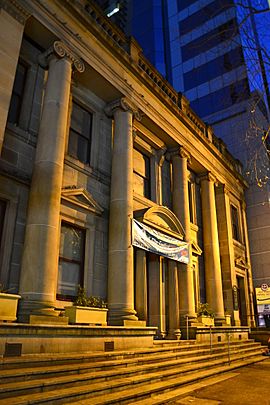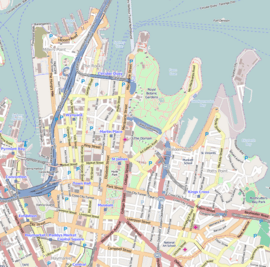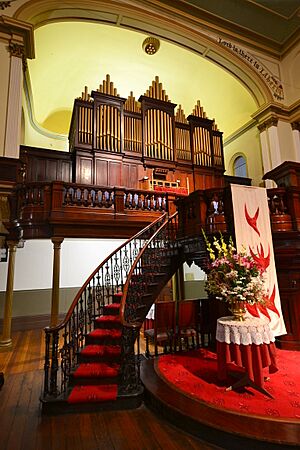Pitt Street Uniting Church facts for kids
Quick facts for kids Pitt Street Uniting Church |
|
|---|---|

Pitt Street Uniting Church in 2012
|
|
| 33°52′25″S 151°12′30″E / 33.8735°S 151.2084°E | |
| Location | 264 Pitt Street, Sydney, New South Wales |
| Country | Australia |
| Denomination | Uniting Church in Australia |
| Previous denomination | Congregationalism |
| History | |
| Former name(s) | Pitt Street Congregational Church |
| Status | Church |
| Founded | 1842 |
| Architecture | |
| Functional status | Active |
| Architect(s) |
|
| Architectural type | Church |
| Style | Old Colonial Georgian Classical |
| Years built | 1841–1846 |
| Specifications | |
| Materials |
|
| Administration | |
| Synod | New South Wales and ACT |
The Pitt Street Uniting Church is a very old and important church building in Sydney, Australia. It is located at 264 Pitt Street in the city center. This church is part of the Uniting Church in Australia. It was first started in 1833 as a Congregational church, which was a different type of Christian church at the time.
The church building you see today was designed by John Bibb. It was built between 1841 and 1846. It is also known by its older name, Pitt Street Congregational Church. The Uniting Church in Australia owns this historic property.
Contents
A Look Back: History of the Church
The church community began meeting in 1833 in a different building nearby. As more people joined, they needed a bigger place. So, the first stone for the current building was laid in 1841. However, there was an economic recession (a time when money was tight), so it took longer to finish. The church was finally completed in 1846.
In 1867, the church was made even bigger and better. An architect named George Allen Mansfield led this big renovation. They added more to the outside sandstone walls and changed parts of the inside.
The church was always interested in important social issues, like education. It helped start groups like the Boys' Brigade and the YMCA.
In 1928, a building called Church House (now Pilgrim House) was built next door. This was an early idea to create spaces that could be rented out. The money earned would help support the church's activities. This idea came from Rev. T. E. Ruth, who wanted the church to do more for the community.
In the 1960s, there was a plan to knock down the church building. But people who cared about the church asked for help. Jack Mundey and the Builders Labourers Federation stepped in. They put a "green ban" on the project. This meant workers would not help demolish the building, which saved it!
By the mid-1970s, the church community worked hard to bring new life to the church. They started fixing up the church and Pilgrim House. In 1977, the church officially became part of the Uniting Church. Since then, there have been more efforts to restore the building, with help from grants in the 1980s and 1990s.
The Church's Design: Architecture
The outside of the Pitt Street Uniting Church shows a style called Old Colonial Georgian Classical design. It has a grand front made of Sydney sandstone. This front is symmetrical, meaning it's the same on both sides. It features large Ionic columns that go up two stories. These columns support a decorative top part and a railing.
You can enter the building by walking up a few steps to a small platform. The other walls of the church are made of brick. Inside, there are galleries (like balconies) that run along the walls. These are supported by cast iron columns. The main pulpit and platform are reached by two stairs with cast iron railings. All the wooden parts inside are made from local cedar wood.
The original design was by John Bibb, an English-trained architect. He also helped design other important buildings in Sydney. Later, between 1857 and 1867, architect GA Mansfield made the church bigger. He added the inside galleries and a vestry (a room for clergy) at the back.
The church's organ is very special. It is one of the most important organs from the Edwardian period in New South Wales. It is also one of the few organs of its kind by the company Hill and Son that still exists in Australia.
Changes Over Time
- 1867 – A new central pulpit and platform were added inside the church.
Important People Connected to the Church
Many famous people from Sydney have been part of this church. The walls inside are covered with plaques that remember these people. Some notable members include David Jones, who started the famous department store, and John Fairfax, who founded a major newspaper. Other important figures were Rev. John West and Rev. Joseph Coles Kirby.
In 1951, Hilda May Abba made history at this church. She was the first woman in Australia to be ordained as a theological lecturer. From 1983 to 1993, Rev. Dr Dorothy McRae-McMahon was the minister here. She and the church community strongly supported the anti-Apartheid movement in Sydney.
Why This Church is Special: Heritage Listing
The Pitt Street Uniting Church has played a big role in the social and religious history of Australia. It has always been a church that cared about the community and new ideas. Its design is considered one of the best examples of Neo Classicism in Australia. It's a great example of architect John Bibb's work.
This church was the very first Independent Church in Australia. It was deeply involved in local issues and supported important social traditions. It even helped set up one of the first city missions.
The Pitt Street Uniting Church was added to the New South Wales State Heritage Register on April 2, 1999. This means it's officially recognized as a very important historical building.
The church is important because it shows the history of New South Wales.
- John Bibb, who designed the church, also designed other famous buildings like Elizabeth Bay House.
- You can find memorials inside the church to important people like David Jones and James Fairfax.
- The Pitt Street Church is known as the "Mother Church" for Congregationalism in mainland Australia. It was the first Independent Church in Australia.
The church is important for its beautiful design and high quality of building in New South Wales.
- Its grand Neo Classic design is considered the best of its kind in Australia.
- The organ inside the church is a very significant and substantial organ from the Edwardian period.




